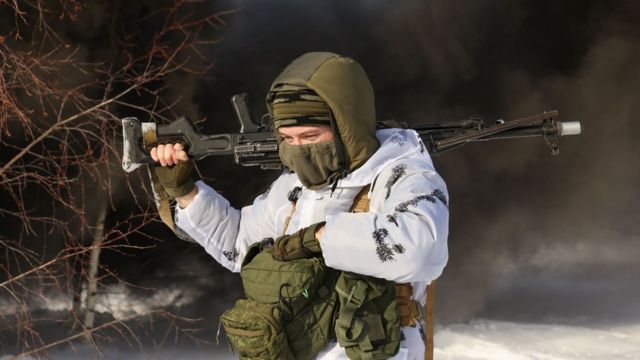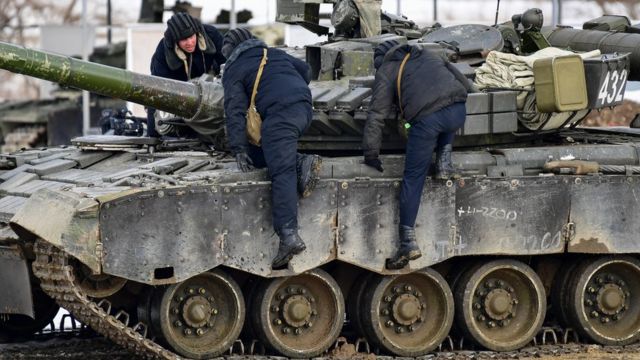Russia is preparing a new big offensive in Ukraine, which will begin in the next two weeks. Such warnings have recently been heard from Ukrainian and Western officials, they are also contained in publications citing informed anonymous sources. How will events develop at the front?
If you believe the statements of Ukrainian officials and media publications, several directions are under threat at once: the southern part of the Donetsk region, the Melitopol region, the outskirts of the cities of Bakhmut and Vugledar, where fierce battles have been going on for a long time, as well as Liman in the west of the Lugansk region, liberated by the Ukrainian army during the autumn offensive .
“There are already many reports that the occupiers want to do something symbolic in February. Try to win back for their last year’s defeats. We will see this increased pressure in different directions of the front, as well as pressure in the information field,” the President said on Sunday evening. Ukraine Volodymyr Zelensky.
Last week, Minister of Defense of Ukraine Oleksiy Reznikov and head of the National Security and Defense Council (NSDC) Oleksiy Danilov warned that Russia would launch an offensive. They say the offensive should begin by February 24, which marks the one-year anniversary of Russia’s full-scale invasion of Ukraine.
Finally, the Financial Times wrote , citing an unnamed “Ukrainian army adviser,” that Kiev had received “very reliable information” that an offensive could begin in the next 10 days.
Where can the attack start?

An indirect sign that the Russian army was really preparing an offensive was its activity in several directions.
As the Minister of Defense of Ukraine Oleksiy Reznikov said in an interview with Ukrainska Pravda, now the most serious groups of the Russian army are in the east and south.
In the Donetsk region, the front line juts out into Russian positions in several wedges: in the area of Vuhledar, where fierce fighting has been going on since November; near Avdiivka; in the area of the city of Bakhmut, which they are trying to surround and capture the Russian troops together with the Wagner PMC.
Each such ledge has the potential to turn into an encirclement, but so far the advance of Russian troops in the Donetsk region has been extremely slow. These areas were being prepared for defense even before the invasion began.
On the other hand, the capture of Donbass is a political task set by the Russian leadership, and the likelihood that an offensive will begin in this region is quite high, Kirill Budanov, head of military intelligence of Ukraine, told the Washington Post in an interview. According to him, in 2023 Russia will focus on the capture of the Donetsk and Luhansk regions.

The second dangerous direction is the Zaporozhye region. Here the front line is too close to the railway line that runs through Fedorovka, Kamysh-Zarya and Volnovakha. This line is important for supplying the entire grouping of Russian troops in southern Ukraine, and therefore the idea of pushing the front line to the north may look very tempting to the Russians.
As a Ukrainian military source told the Financial Times, Russia is increasing its grouping in the south of the Donetsk region, deploying additional forces in the villages around the occupied Mariupol.
The area of the city of Kremennaya in the west of the Luhansk region is also under threat – until recently it was an obvious target of the autumn offensive of the Armed Forces of Ukraine, but it was not possible to take it. Now there are battles there and it is possible that Russian troops may launch an offensive towards the nearby Liman, recaptured by the Ukrainians in the fall.
“This week, the Russian occupying troops have thrown all their forces into breaking through our defenses and the cordon of Bakhmut, and also launched a powerful offensive in the direction of Liman,” Deputy Defense Minister of Ukraine Anna Malyar said on Saturday.
In less danger, according to the general assessment, there are directions from Belarus to the capital of Ukraine and from the Bryansk, Kursk and Belgorod regions of Russia – across the state border. Border settlements are periodically shelled, but so far there has been little activity on the part of the Russian army in this area.
How is the offensive prepared?
Attacking is much more difficult than defending. In preparing an offensive, the headquarters of any army is faced with a rather difficult task. On the one hand, you need to accumulate strength for a strike, because a quantitative advantage is the most important success factor. On the other hand, it is necessary to make sure that the enemy does not accumulate reserves and the blow does not turn into a trap.
At the same time, it is necessary not only to accumulate invasion forces, but also to make other preparations: we need fuel, ammunition, field hospitals.
In modern warfare, it is very difficult to do this covertly – both sides use unmanned aerial vehicles, radars, satellite images and other reconnaissance tools that make it possible to identify a strike force even at the deployment stage.

Surprise can be ensured by covert deployment. The Russian army practiced such techniques during exercises, in particular in 2021 in Belarus. True, everything here depends on the scale – even in the deep rear it is difficult to hide the deployment of a large group.
Before the start of the summer offensive, the Armed Forces of Ukraine were able to ensure the covert deployment of the strike force, but this offensive was not so large-scale.
Another way to give an advancing force an advantage is through distraction strikes that force the enemy to disperse reserves.
It is generally accepted that the attacking forces suffer losses in relation to the defenders in the ratio of 3 to 1. Accordingly, it is important not only to ensure the superiority of the strike force, at least in this ratio, but also to prevent the defenders from accumulating forces.
At the end of the summer, the Armed Forces of Ukraine were active in the Kherson region, diverting the attention of the Russian command to themselves, before striking in a completely different place (and then continuing near Kherson).
The preparation of a new offensive by Russia may just be indicated by the fact that its signs, judging by open data, are observed in several directions at once.
It is even more difficult to judge what character it will be. If Russia intends to break through the front and carry out a deep offensive with decisive goals to the entire depth of defense with the encirclement of the Armed Forces of Ukraine, then this can only be done with a multiple superiority of forces.
Theoretically, the Russian army is able to accumulate them in one place, but for such a breakthrough to be successful, this must be done as covertly as possible, which, given the current level of intelligence, seems difficult to implement.
Another option is to continue the slow advance tactics by reinforcing troops in a certain area or several at once. In such a situation, Russia can use the overall numerical superiority in manpower, armored vehicles, aviation and artillery. But the slow pace may allow Ukraine to build up reserves and contain the pressure.
When?
In addition to the symbolic date of February 24, which, as many fear, Russia may time a new offensive, there are two more circumstances that could spur the Russian General Staff to plan offensives. This is the weather and Western weapons, which will begin to receive the Armed Forces of Ukraine.
In the past few weeks, Ukraine’s military assistance program has seen a real breakthrough – Ukraine has been promised supplies of main battle tanks, heavy infantry fighting vehicles, artillery systems, precision-guided munitions, anti-aircraft missile systems and much more.
Some of the things promised by the West will get to Ukraine faster, some more slowly. Deliveries may take several months. However, it is known that the first Leopard 2 tank went to Ukraine last Saturday. On the same day, the British Army said that the Ukrainian crews of the Challenger 2 tanks were already in full swing learning to use the vehicles on the battlefield.
In the near future, the Armed Forces of Ukraine will begin to receive new equipment, and even a very small amount of it will strengthen the Ukrainian army.
Time also helps Russia – it needs it in order to prepare the people mobilized in the autumn as best as possible. Now, according to Kirill Budanov, Russia has about 326,000 soldiers at the front.
A Ukrainian military adviser, in an anonymous interview with the Financial Times, suggested that the Russian offensive would likely be led by elite units. “These are real mechanized brigades, even if they are less combat-ready than they were at the beginning of the war. They were reinforced by units of the Airborne Forces and the Marine Corps. These are not bus drivers and not teachers,” the newspaper quotes him.
Finally, the weather factor. In April, mud will begin, which will make the off-road terrain difficult even for light tracked vehicles. The Russian army already faced this at the very beginning of the invasion. Therefore, the “meteorological window” for the offensive is decreasing every day.
Source : BBC


